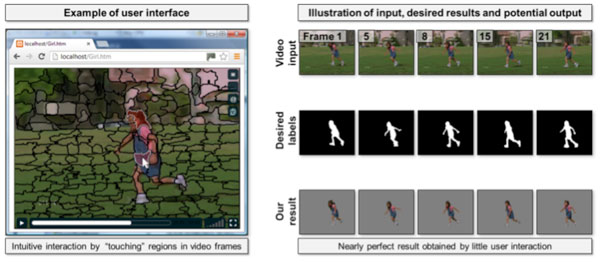Contacts: Ignas Budvytis, Dr. Vijay Badrinarayanan, Prof. Roberto Cipolla, Department of Engineering, Cambridge Interactive Video Solutions Ltd.
Mentor: Adrian Swinburne
Website: http://www.cambridgeivs.com
The research team, working in the Department of Engineering under the supervision of Professor Roberto Cipolla, have developed a new technique for segmenting videos that enables individual objects and their respective boundaries to be tracked automatically through sections of video content. The patent-pending techniques have been published and built into a software demonstration suite that will be released to the academic community in late autumn. The inventors have already set up a spin-out company, Cambridge Interactive Video Solutions, and were £5k prize-winners in the CUE Business Creation Competition in 2012.

The first application area for the demo suite will allow the software algorithms to be used as a much-needed tool for computer vision researchers to help gather ground-truthed data for large-scale evaluation of their own research projects. Beyond this, video segmentation has a wide and diverse range of uses, from creating clickable/interactive objects in videos to tracking biological cells to measuring how much screen time a company’s logo gets in a sports event. While there is a wide spectrum of similar technologies already in use, ranging from manual identification of objects in individual video frames, through to object recognition techniques, they are often focusing on identifying and marking the centre as opposed to an area of an object.
The uniqueness of this approach lies in its computational efficiency and intuitive user interaction which allows for inexperienced users to easily and intuitively label objects in videos. This opens up a huge opportunity in tablet (e.g. iPad) and smartphone markets. It works by tracking user selected edges through multiple video frames, without needing to resort to computationally and technologically expensive object recognition techniques. Manual intervention may be needed on some video frames to identify which segments combine to make a complete object and to correct labelling errors, if they occur. Like all video analysis techniques, these algorithms have their own specific benefits and limitations, and the challenge is always to find the particular set of real-world applications that best exploits the benefits.
The task for the i-Team is to investigate the various markets which need object segmentation and tracking within videos, and identify those which best fit the characteristics of this particular technology.
Relevant publications:
* Budvytis, I., Badrinarayanan, V., Cipolla, R., “Semi-Supervised Video Segmentation using Tree Structured Graphical Models”.
In Proc. IEEE Conference on Computer Vision and Pattern Recognition, Colorado Springs, June 2011. [pdf]
* Budvytis, I., Badrinarayanan, V., Cipolla, R., “MoT – Mixture of Trees Probabilistic Graphical Model for Video Segmentation”.
In Proc. British Machine Vision Conference, Surrey, September 2012. [pdf]
* Badrinarayanan V., Budvytis, I., Cipolla, R., “Semi-Supervised Video Segmentation using Tree Structured Graphical Models”.
IEEE Transactions on Pattern Analysis and Machine Intelligence, 2013. [to appear]
